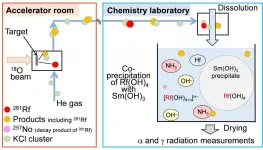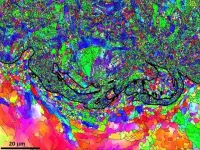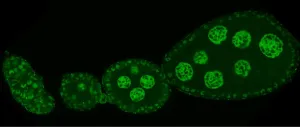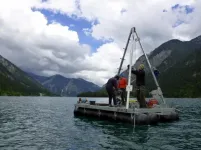INFORMATION:
Plant as superhero during nuclear power plant accidents
Potassium-independent cesium transporters
2021-02-16
(Press-News.org) In recent time, HBO's highly acclaimed and award-winning miniseries Chernobyl highlighted the horror of nuclear power plant accident, which happened in Ukraine in 1986. It is not a fictional series just on TV. As we had seen such a catastrophic nuclear power plant accident in 2011 again caused by natural disaster, Tsunami, in Japan. Both historical nuclear power plant accidents released tons of radioactive cesium to the environment. Consequently, the radioactive cesium found their way to the surrounding land, river, into the plants and animal feed, and eventually to our food cycle and ecosystem. The more detrimental part is their half-life, as 137Cs has half-life of ~30 years. So, it is going to be a serious agricultural, economic, and health problem for such a long time without effective actions. Plant biologists use the technique call phytoremediation to use the plant or manipulate the plant genetically to take up toxic components from soil or make crop plants resilient to such contaminated soil. Over the years, scientists tried to find cesium transporters in plants, and till now mostly ended up with several potassium transporters. It is not surprising if someone thinks about the basic chemistry and periodic table of elements we learnt in the high school. Cesium (Cs) resides in the same group with potassium (K). But potassium is abundant in soil and important for plant growth and development. As a result, manipulating potassium transporter to regulate cesium uptake will cause problem for plant growth in general. In contrast to potassium, cesium is not abundant in the soil and it is toxic for plants. So, the idea of finding potassium-independent cesium transporter, which will transport cesium without affecting potassium, is a long waited one.
Recently, plant biologist Dr. Abidur Rahman's group from Iwate University, Japan in a collaboration with Dr. Keitaro Tanoi from the University of Tokyo and Dr. Takashi Akihiro from the Shimane University reported two potassium-independent cesium transporters, where these two transporters dedicatedly uptake cesium inside the plant without affecting potassium. Their finding has been published recently in the top tier plant-specific journal from Cell press, Molecular Plant. They have shown that two ATP Binding Cassette (also known as ABC transporter in general and evolutionary abundant across the kingdom) proteins, ABCG33 and ABCG37, uptake cesium inside the cell.
"This study highlights how we can solve the agricultural issues around us with basic research and why the basic research should be funded". This study also demonstrates the power of collaborations to answer the scientific questions" said the group leader Dr. Abidur Rahman.
"Arif Ashraf,one of the lead authors who conducted the study as part of his graduate study in the Iwate University and currently a postdoc at the University of Massachusetts Amherst, said that how the basic plant biology research can solve real-life problem around us" He added, "In this study, we combined plant physiology, molecular biology, cell biology with in planta transport assay using radioactive cesium, and heterologous system such as yeast, as well".
These transporters are first step forward towards the basic understanding of potassium-independent cesium transport in plant and promise for future bioremediation. Based on their current finding and proposed model, it suggests that possibly more potassium-independent cesium transporters are yet to discover in plant. Abidur lab is working on finding other unknown cesium transporters. Deciphering the basic mechanism and finding more transporters in this regard will help to develop phytoremediation technique possible and translate this mechanism from model plant to crop plants, as these reported transporters are also conserved in crop plants and other species.
ELSE PRESS RELEASES FROM THIS DATE:
HKU planetary scientists discover evidence for a reduced atmosphere on ancient Mars
2021-02-16
Both Earth and Mars currently have oxidising atmospheres, which is why iron-rich materials in daily life develop rust (a common name for iron oxide) during the oxidation reaction of iron and oxygen. The Earth has had an oxidising atmosphere for approximately two and a half billion years, but before that, the atmosphere of this planet was reducing - there was no rust.
The transition from a reduced planet to an oxidised planet is referred to as the Great Oxidation Event or GOE. This transition was a central part of our planet's evolution, and fundamentally linked to the evolution of life here - specifically ...
Experimental tests of relativistic chemistry will update the periodic table
2021-02-16
Osaka, Japan - All chemistry students are taught about the periodic table, an organization of the elements that helps you identify and predict trends in their properties. For example, science fiction writers sometimes describe life based on the element silicon because it is in the same column in the periodic table as carbon.
However, there are deviations from expected periodic trends. For example, lead and tin are in the same column in the periodic table and thus should have similar properties. However, whilst lead-acid batteries are common in cars, tin-acid batteries don't work. Nowadays ...
International team first to stack virus resistance plus iron & zinc in a non-cereal crop
2021-02-16
ST. LOUIS, MO, February 16, 2021 - Delivering the benefits of agricultural biotechnology to smallholder farmers requires that resources be directed toward staple food crops. To achieve effect at scale, beneficial traits must be integrated into multiple, elite farmer-preferred varieties with relevance across geographical regions. For the first time, an international team of scientists, led by Narayanan Narayanan, Ph.D., senior research scientist, and Nigel Taylor, Ph.D., associate member and Dorothy J. King Distinguished Investigator at the Donald Danforth Plant Science Center, and their collaborators in Nigeria, led ...
Breakthrough in the fight against spruce bark beetles
2021-02-16
For the first time, a research team led by Lund University in Sweden has mapped out exactly what happens when spruce bark beetles use their sense of smell to find trees and partners to reproduce with. The hope is that the results will lead to better pest control and protection of the forest in the future.
The Eurasian spruce bark beetle uses its sense of smell to locate trees and partners. The odours are captured via odorant receptors (proteins) in their antennae. Researchers have long understood the connection, but so far they have not known exactly which receptors bind to what pheromones. ...
Secret to how cholera adapts to temperature revealed
2021-02-16
Scientists have discovered an essential protein in cholera-causing bacteria that allows them to adapt to changes in temperature, according to a study published today in eLife.
The protein, BipA, is conserved across bacterial species, which suggests it could hold the key to how other types of bacteria change their biology and growth to survive at suboptimal temperatures.
Vibrio cholerae (V. cholerae) is the bacteria responsible for the severe diarrhoeal disease cholera. As with other species, V. cholerae forms biofilms - communities of bacteria enclosed in a structure made up of sugars and proteins - to protect against predators and stress conditions. V. cholerae forms these biofilms both in their aquatic environment and in the human intestine. There is evidence to suggest that biofilm ...
Solution to puzzling phenomenon may open door to improved Cold Spray efficiency
2021-02-16
An international team of researchers has solved a puzzling phenomenon whereby strangely beautiful, vortex-like structures appear between materials deposited onto engineering components used in multiple settings - from space shuttles to household items and everyday transport vehicles.
The discovery may ultimately improve the efficiency of the "Cold Spray" (CS) deposition process from which these structures are formed - a not-insignificant consideration from a financial perspective, or from a functional one given that some of the materials created by CS are pushed to the limit in outer space.
The discovery is featured on the front cover of international journal, Materials & Design.
Cold Spray (CS) and deposition efficiency (DE)
CS enables the formation of coatings, ...
Silencing by crosstalk
2021-02-16
Why do genes need to be silenced? The "genes" in question are in fact transposons, selfish genetic elements that seek to self-multiply at the host's expense and that need to be controlled. Julius Brennecke's group at IMBA focuses on lifting the mysteries of a specific type of transposon silencing, namely the piRNA pathway in animal gonads. Understanding this ancient silencing system promises to reveal general mechanistic principles of gene expression and chromatin biology.
Gene silencing: either before they "speak", or right as they attempt to
Heterochromatin, a tightly packed form of DNA, plays an essential role in transposon ...
Past earthquakes triggered large rockslides in the Eastern Alps
2021-02-16
Many steep valleys in the European Alps show the relicts of large rockslides, during which several hundreds of million cubic metres of rocks get instable, collapse and impact everything on their path. "For most of these, we still do not know how they are caused, because these rockslides occurred long before the start of written history in the region about 1000 years ago," says Patrick Oswald, PhD student at the Department of Geology of the University of Innsbruck and lead author of the study. "Curiously, many of these ancient rockslides occurred together in clusters, meaning they are found in small regions and have a rather comparable age". This enigmatic pattern has puzzled researchers over the last decades and fuelled some intense debates. Some experts ...
Nanotechnologies reduce friction and improve durability of materials
2021-02-16
"Thin films are solid state substances that can be only several atomic layers thick. Usually, their properties are considerably different from the properties of the original substances on the macroscale. The areas of their application keep expanding and include nanoelectronics, optoelectronics, spintronics, electro-, and photocatalysis, as well as such important fields of economics as space technologies and instrument building. Micromodule devices for space crafts and medical technologies are also promising areas in which thin films can be used," said Vyacheslav Fominski, a project supervisor representing MEPhI.
To reduce friction and solve many ...
Cloudy eyes caused by protein imbalance
2021-02-16
Cataracts are the most common eye ailment in humans. However, the exact processes leading to this condition are not fully understood. A team of researchers headed by the Technical University of Munich (TUM) has now discovered that the composition of the protein solution plays a decisive role. Their conclusions are contrary to prevailing opinion in the field.
The cells in the lens consist of a highly concentrated protein solution that is normally clear. "When the balance of the proteins in the lens is destroyed, they clump together and the lens becomes cloudy," says Prof. Johannes Buchner of the Chair of Biotechnology at TUM. This results in the condition known as cataracts.
The clouding can have different causes. Because the proteins in the lens are formed ...
LAST 30 PRESS RELEASES:
Tracing the quick synthesis of an industrially important catalyst
New software sheds light on cancer’s hidden genetic networks
UT Health San Antonio awarded $3 million in CPRIT grants to bolster cancer research and prevention efforts in South Texas
Third symposium spotlights global challenge of new contaminants in China’s fight against pollution
From straw to soil harmony: International team reveals how biochar supercharges carbon-smart farming
Myeloma: How AI is redrawing the map of cancer care
Manhattan E. Charurat, Ph.D., MHS invested as the Homer and Martha Gudelsky Distinguished Professor in Medicine at the University of Maryland School of Medicine
Insilico Medicine’s Pharma.AI Q4 Winter Launch Recap: Revolutionizing drug discovery with cutting-edge AI innovations, accelerating the path to pharmaceutical superintelligence
Nanoplastics have diet-dependent impacts on digestive system health
Brain neuron death occurs throughout life and increases with age, a natural human protein drug may halt neuron death in Alzheimer’s disease
SPIE and CLP announce the recipients of the 2025 Advanced Photonics Young Innovator Award
Lessons from the Caldor Fire’s Christmas Valley ‘Miracle’
Ant societies rose by trading individual protection for collective power
Research reveals how ancient viral DNA shapes early embryonic development
A molecular gatekeeper that controls protein synthesis
New ‘cloaking device’ concept to shield sensitive tech from magnetic fields
Researchers show impact of mountain building and climate change on alpine biodiversity
Study models the transition from Neanderthals to modern humans in Europe
University of Phoenix College of Doctoral Studies releases white paper on AI-driven skilling to reduce burnout and restore worker autonomy
AIs fail at the game of visual “telephone”
The levers for a sustainable food system
Potential changes in US homelessness by ending federal support for housing first programs
Vulnerability of large language models to prompt injection when providing medical advice
Researchers develop new system for high-energy-density, long-life, multi-electron transfer bromine-based flow batteries
Ending federal support for housing first programs could increase U.S. homelessness by 5% in one year, new JAMA study finds
New research uncovers molecular ‘safety switch’ shielding cancers from immune attack
Bacteria resisting viral infection can still sink carbon to ocean floor
Younger biological age may increase depression risk in older women during COVID-19
Bharat Innovates 2026 National Basecamp Showcases India’s Most Promising Deep-Tech Ventures
Here’s what determines whether your income level rises or falls
[Press-News.org] Plant as superhero during nuclear power plant accidentsPotassium-independent cesium transporters






